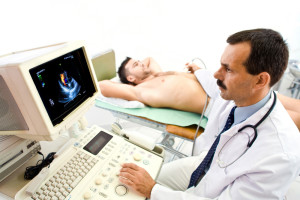Pulmonary hypertension refers to elevation of the pressures within the blood vessels of the lungs (pulmonary arteries). As Idiopathic Pulmonary Fibrosis progresses and more lung tissue is replaced by fibrosis or scar formation there is a reduction in the blood vessels that move blood through the lungs. Gradually the pressures increase leading to the development of pulmonary hypertension.
It is very common for mild pulmonary hypertension to develop. In some patients, marked elevation in pulmonary artery pressure occurs. The right ventricle is responsible for pumping blood through the blood vessels of the lungs. Normally the pulmonary arteries are wide open and carry blood under low pressure. When pulmonary hypertension develops, the right ventricle has to work harder to move blood through the lungs. Over time this extra work leads to the development of fluid retention that is seen as swelling in the ankles and abdomen. Eventually the right ventricle is unable to keep up and right heart failure develops. This leads to declining blood flow and increasing symptoms of fatigue, shortness of breath and fluid retention.
 The development of more than mild pulmonary hypertension in the context of IPF is a marker for more advanced disease. These patients often require more oxygen and have greater symptoms and exercise limitation. There is not always a direct relationship between the severity of the IPF and the pulmonary hypertension.
The development of more than mild pulmonary hypertension in the context of IPF is a marker for more advanced disease. These patients often require more oxygen and have greater symptoms and exercise limitation. There is not always a direct relationship between the severity of the IPF and the pulmonary hypertension.
Pulmonary artery pressures are estimated using echocardiography (an ultrasound of the heart). However, in lung disease, the echocardiogram is not very accurate so pressure estimates by echocardiogram are unreliable for diagnosis. The only accurate technique to measure pulmonary artery pressure is by right heart catheterization. This involves placing a catheter through a peripheral vein in your leg or neck and then advancing a long catheter through the heart chambers into the pulmonary arteries. This direct measurement allows determination of blood flow as well.
Treatment of Pulmonary Hypertension in Idiopathic Pulmonary Fibrosis
Several studies have been performed looking at different medicines to treat pulmonary hypertension in IPF. None have been a huge success. There are four classes of medications that are approved to treat a different type of pulmonary hypertension (Pulmonary Arterial Hypertension). The most studied family is the Endothelin Receptor Antagonists (ERAs). This family of medications has been shown to have no role in IPF patients with or without pulmonary hypertension. A second family of medications called Phosphodiesterase V inhibitors (PDEVinh) has yielded slightly more encouraging results. Sildenafil (the active ingredient in Viagra) was shown to improve symptoms in a study. The other two families of medications called Prostanoids and Soluble Guanylate Cyclase Stimulators (sGC) are under study.
In patients with IPF and very severe pulmonary hypertension there are suggestions that continuously infused prostanoids may provide some benefit but definitive data is lacking. In my practice, I assess whether the pulmonary hypertension is mild relative to the degree of IPF or if there is pulmonary hypertension out of proportion to the degree of fibrosis. In patients with severe pulmonary hypertension, especially with out of proportion disease, I often undertake an aggressive course of pulmonary hypertension treatment. Lung transplantation should always be considered in patients with IPF and pulmonary hypertension. Other general measures include oxygen and avoidance of high elevations. Diuretics are used to treat fluid retention.